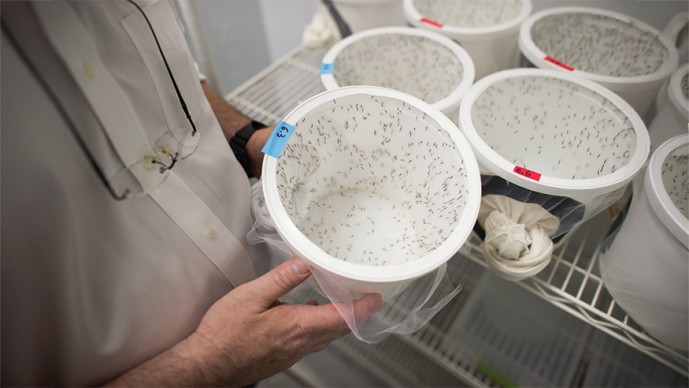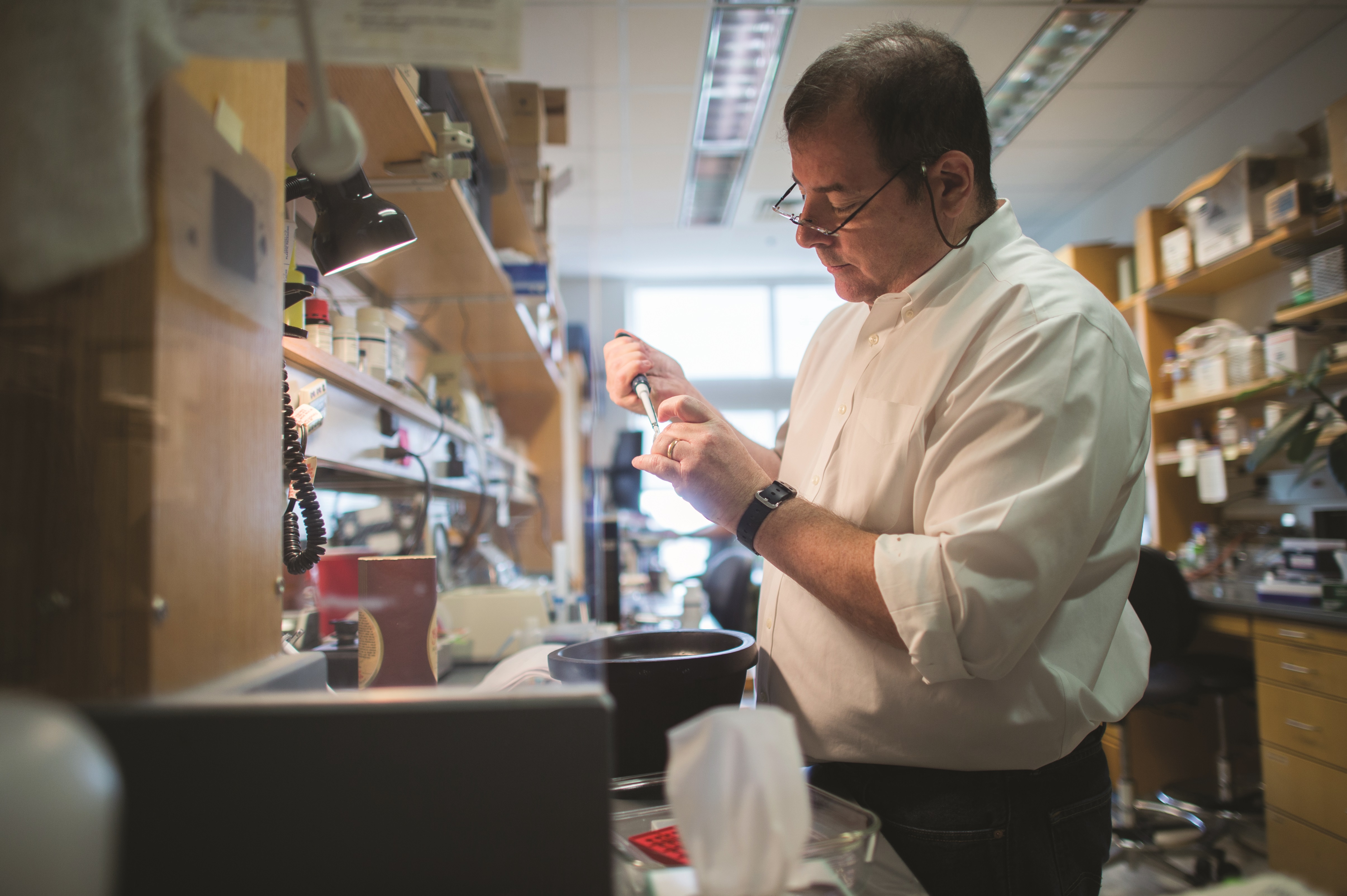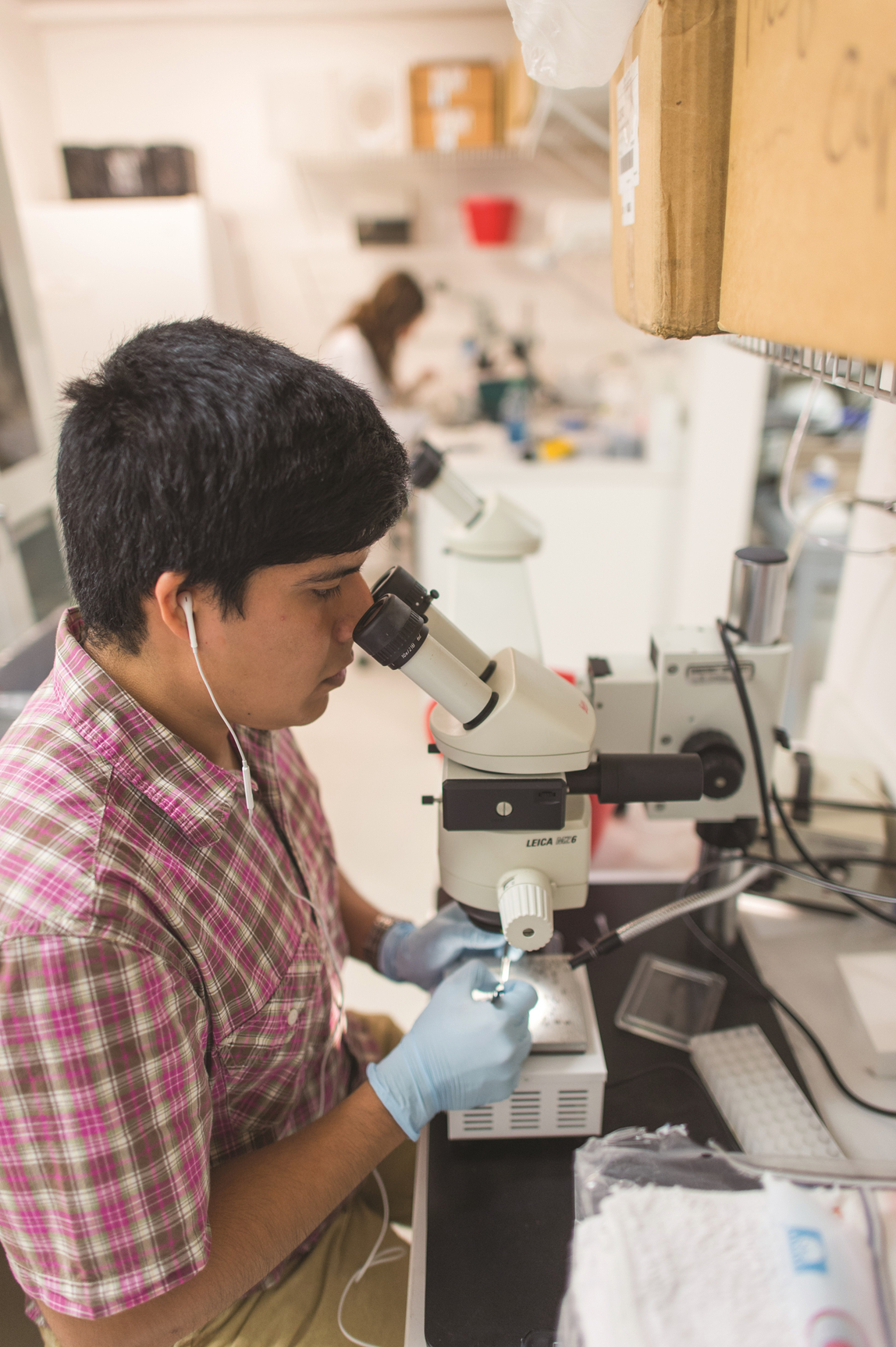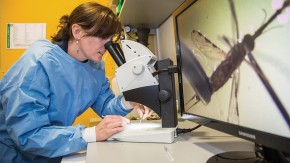Laurence Zwiebel at his bench in the lab where he and his team have been working on a new mosquito repellent.
DISRUPTION OF MALARIA TRANSMISSION BY CHEMICAL MANIPULATION OF ANOPHELINE OLFACTORY RESPONSES
- Jan 1, 2016
- Download Retrospective

Buckets of mosquitoes used for experiments to identify powerful new repellents are stored in the laboratory.
Laurence J. Zwiebel, Vanderbilt University, United States
Professor Laurence Zwiebel leans forward in his chair at his office near his laboratory at Vanderbilt University and declares, "I am the luckiest guy in the world."
Chief among what fuels his good fortune, Zwiebel says, is the $8.9 million, five-year grant he and a consortium of research groups received in 2005 from the Bill & Melinda Gates Grand Challenges in Global Health program. As a result of seven years of study - in 2010 they won a two-year, $2 million extension of the Gates award - Zwiebel and his colleagues John Carlson at Yale University, Willem Takken at Wageningen University in the Netherlands, Richard Mukabana at the International Centre for Insect Physiology and Ecology in Kenya, and David Conway with the Medical Research Council in The Gambia have uncovered new ways to prevent malaria-transmitting mosquitoes from biting humans. In particular, the researchers discovered a compound they call VUAA1, which disrupts the insect's ability to recognize humans. It has the makings of a bug repellant unlike any previously developed, Zwiebel asserts.
In late 2014, a group of private investors created Citadel Protectants, based in Atlanta, to develop VUAA1 into a commercial product. Citadel's business plan is to produce a repellant related to the compound against mosquitoes that transmit malaria and dengue fever, as well as agricultural agents against other crop-destroying insects.[1]
"It's a potential game changer" in the worldwide effort to eradicate malaria, says Zwiebel. VUAA1 (for Vanderbilt University Allosteric Agonist One) works by overloading an insect's sense of smell, flooding it with so many odor-emitting signals that the bug can't distinguish one aroma from another, blinding it to the presence of people. "It's like walking into an elevator with a woman with way too much perfume, or someone blasting a boom box," he says. "It overwhelms you."
Zwiebel demonstrated how the compound produces a sensory overload during a presentation at the Grand Challenges in Global Health's 2013 annual meeting in Rio de Janeiro. Placing a microphone to his mouth, Zwiebel blasted out several words so loudly many in the audience put their hands to their ears. "Sorry," said Zwiebel, a gregarious wit with a penchant for sprinkling his conversations with clever verbal illustrations and analogies. "Just making a point."
Finding new ways to shield humans from the mosquitoes that carry malaria is a vital front in the global battle against the disease. About 600,000 people die annually in Africa and other tropical regions - most of them children - due to a bite from the Anopheles gambiae mosquito that carries the malaria parasite Plasmodium falciparum.
Pesticides such as DDT, while effective can be toxic to other animals, plants or humans. Repellants similar to DEET, the active set of chemicals in many consumer sprays, mostly work by blocking and confusing an insect's odor-detecting apparatus. But insects are developing resistance to these products. VUAA1, says Zwiebel, represents a new paradigm: warding off an insect not by confusing it with the absence of information but terrorizing it with too much stimulation. The Vanderbilt compound is the first in a new class of agents Zwiebel calls "behavior disrupting olfactory agonists."
Vanderbilt has applied for a patent and at several companies VUAA1 is now being developed as a commercial product. But the basic science behind VUAA1's discovery required the kind of high-risk venture "no corporation would have gambled on," says Zwiebel. "We'd be nowhere without Gates backing."
When the Grand Challenges in Global Health grants were first announced in 2005, Zwiebel already had been investigating mosquito olfaction with John Carlson and Willem Takken. In the late 1980s, Zwiebel had studied the genetics of behavior in the fruit fly (Drosophila melanogaster) while working on his doctorate in molecular biology. But for his post-doctoral work, Zwiebel switched to Anopheles gambiae, the mosquito that transmits the majority of malaria parasites in Africa. He did so because the mosquito’s central role in spreading disease "makes it the most important insect to study," Zwiebel explains. And, as many academic research laboratories were using new molecular biology tools to pick apart fly genetics, Zwiebel wisecracks that by transferring to Anopheles, "I figured I'd have a better chance of landing a university job."
Carlson, meanwhile, had spent much of the late 1990s studying olfactory genetics of Drosophila. "The holy grail in understanding Drosophila behavior was identifying the receptors that respond to smell," he says. When the genome of the fly was sequenced in 1998, Carlson and another colleague, along with others including Leslie Vosshall and Richard Axel, two other recipients of a Bill & Melinda Gates Grand Challenges in Global Health grant who were working independently, scanned the insect's DNA and identified the genes that express odor receptors in nerve cells.[2],[3] Noting that he was aware that studies in mosquito olfaction would have a significant impact on public health in the developing world, "I realized there was an opportunity to do in the mosquito what we'd accomplished in the fly," Carlson says. "I knew Larry and knew he was working on mosquitoes, so I called him up."
"The Grand Challenges was a discovery mandate that we feel we fulfilled and then some," Zwiebel says. "Our job is now to hand that discovery to people who know how to carry out the next step."
Carlson's lab created a powerful test called the "empty neuron" to begin cataloguing precisely which receptors were activated when exposed to certain odors. His group created a mutant fly that lacked odorant response in a specific antennal neuron. They inserted mosquito genes for each of the receptors they wanted to test, exposing them, one by one, to a panel of about 100 odors from sweat extracted from old socks, armpits and other body parts.[4] Because the female Anopheles gambiae must feed on human blood to nourish her fertilized eggs, the researchers knew the insect had developed a sophisticated set of receptors to pick up a wide range of human smells. "What makes Anopheles gambiae the most dangerous animal on the planet is its preference for humans," says Zwiebel. "If you are in a room full of cows, this mosquito will find you and bite you and not the cows."

The Vanderbilt, Yale and Wageningen labs were well along in characterizing which of Anopheles' 72 odor receptors were triggered by human scents when the Gates Foundation's Grand Challenges in Global Health solicited proposals for a new "chemical strategy to deplete or incapacitate a disease-transmitting insect population."
"We were in the right place at the right time," Zwiebel says. "It's why I say I'm a very lucky guy." In addition to identifying the precise receptors that detect humans, the researchers proposed finding chemicals to selectively turn off those receptors to create a repellant, or turn them on to create attractants to draw the bugs away from people. They expected to find these compounds by employing techniques the pharmaceutical industry had developed to screen chemicals for new medicines, even though none of the labs had any experience with the drug-hunting technology. "In retrospect, we were naïve," says Zwiebel.

An undergraduate studies mosquitoes in the Zwiebel laboratory.
At the onset of the project, Zwiebel had another lucky break. The researcher says he was trying to design and set up a system to test compounds against the array of receptors when "someone literally tapped me on the shoulder and pointed out that right next door was the Vanderbilt Institute of Chemical Biology," one of four small-molecule screening centers designated by the National Institutes of Health. Previously unknown to Zwiebel, the institute had a robot-driven high-throughput screening operation similar to those used in the pharmaceutical industry. "I went over there, explained what I needed, and they were more than happy to participate."
The Zwiebel lab had already created what the Institute needed in order to screen large numbers of chemicals, which was a cell line expressing a specific odor receptor. The idea was finding chemicals that could themselves activate this receptor, or that could interfere with its activation by a natural odorant.[5] The institute had a library of 240,000 chemical compounds and, at a rate of about 10,000 a week, began testing to identify which disrupted the connection between the receptor and the odor molecule. Those chemical agents would then be considered as potential agents to deactivate the odor sensory system. Every Thursday the institute lent its robots to the Zwiebel project. By 2009, the combined efforts of the screeners yielded approximately 40 compounds.
About then, four years into the project, the Vanderbilt lab got a visit from a team of consultants they affectionately called "the Mikes" which resulted in focusing the research and, ultimately, its outcome. The Boston Consulting Group was brought in by Foundation for the National Institutes of Health - hired by the Grand Challenges in Global Health to oversee and support the grant - to analyze the economic viability of products being developed by several Grand Challenges grantees. "They were a bunch of very smart guys - all named Mike - and they lived with us for a couple of weeks," Zwiebel recalls. "After a while they came back and said that we'd be unlikely to attract a corporate partner unless our compound could also work as a broad-spectrum agricultural pesticide and generate hundreds of millions of dollars in annual revenue." A mosquito-specific product alone wouldn't justify the risks and costs of development, the consultants said.

The Zwiebel lab has been screening diverse chemical compounds to identify new mosquito repellents.
Recipients of another Grand Challenges in Global Health grant seeking odor-blocking repellants have been given similar advice. Richard Axel of Columbia University and Leslie Vosshall of the Rockefeller University had a two-year collaboration with Bayer CropSciences Inc. of Germany to develop a product that repels agricultural pests as well as mosquitoes. The agreement to create a mosquito-specific agent ended after the two years, but Bayer continues to seek agricultural products related to the Axel-Vosshall research, according to the company.
The Zwiebel-led team of researchers had been working on compounds that were specific to mosquito receptors in order to limit environmental harm. It turns out, in one more stroke of good fortune, that Patrick Jones, Gregory Pask and David Rinker, members of the Zwiebel lab tasked with making sense of the chemical screens, had already noticed just such a potentially wide-acting compound but had ranked it lower precisely because of its broad effects. The compound - later dubbed VUAA1[5] - activated every odorant receptor it was tested against from the mosquito as well as those from a variety of other bugs.[6] "It's like looking at videos of 10 different bank robberies and seeing the same guy in a red hat at all 10 of them," Zwiebel says.
VUAA1 produced its insect-wide repelling action by activating a sensory protein that opened a neural circuit communicating the presence of a specific scent to the insect's central nervous system. The sensory protein, called Orco (short for olfactory receptor co-receptor) was characterized by Leslie Vosshall and colleagues[7] who determined that each odor-specific protein turned on by an odorant molecule needed to lock onto Orco - much as two Lego pieces click together - in order to signal the presence of a specific scent. That meant that in switching on Orco, VUAA1 would in turn activate every Orco-containing complex in the insect's olfactory system.
The membrane pocket activated by VUAA1 was what chemists call allosteric, a chemical lock other than the principal "active" site where odorant receptor subunits normally interact with Orco. "It wasn't what we were looking for," says Zwiebel. "It was much better."
During the course of testing numerous human-derived chemical aromas to identify the receptors, Takken began collecting the most potent of these mosquito-attracting compounds and mixed them into a chemical cocktail. These attractant blends put inside traps can act as powerful human-like decoys for Anopheles (e.g.,[8]). These baits are also being used by other research groups as a way to measure mosquito populations and gather insects for other studies. They may also prove useful as a way to lure the insect away from homes at night when the female Anopheles does most of her blood-hunting. Zwiebel says the combination of the VUAA1 "excito-repellent" and Takken's attractant blend create a perfect "push-pull strategy" that could significantly reduce mosquito bites. Takken's group has used a unique facility, a mosquito microcosm, in Kenya to conduct proof-of-principle studies that show a push-pull strategy against malaria mosquitoes in Africa can reduce mosquito house entrance by more than 95 percent, at least in their experimental setting.[9] By replacing the currently used attractant/repellent combination by even more powerful chemicals, this strategy is likely to make a large contribution to malaria prevention and control.
Zwiebel has used part of the $2 million grant extension to refine VUAA1's chemistry, seeking to produce chemical variants that are more active when released in the air. Vanderbilt's office of technology transfer, which helps link companies to scientists who have developed inventions, reached out to several large pesticide manufacturers interested in VUAA1. To further refine the chemical and test it for toxicity, an interested company would have to invest heavily to produce large amounts of the chemicals. Citadel Protectants was created to carry out this work. Zwiebel is serving as a scientific advisor to the new company.
"The Grand Challenges was a discovery mandate that we feel we fulfilled and then some," Zwiebel says. "Our job is now to hand that discovery to people who know how to carry out the next step. I'm hoping that I will continue to be lucky enough to see that happen."
THE SCIENCE:
Systematic functional analysis of Anopheles gambiae odorant receptors
Insect behavior is largely driven by a highly sophisticated olfactory system composed of a family of odorant receptors (OR) expressed in olfactory receptor neurons. The response of individual ORs to specific odorants enables, for example, the malaria vector mosquito Anopheles gambiae (Ag) to locate its human hosts. Zwiebel, Carlson and colleagues have functionally characterized the OR repertoire of An. gambiae using two complementary model systems: the 'empty neuron' in Drosophila,[4] and Xenopus oocytes.[10]
They expressed each of the 72 putative AgOr genes in a mutant D. melanogaster olfactory receptor neuron lacking its endogenous OR (the empty neuron), and in Xenopus oocytes, exposed them to a chemically diverse panel of odorants including human skin emanations, and measured their response by electrophysiology. In total, almost 12,000 odorant-receptor combinations were analyzed.
They discovered that some ORs were highly tuned to specific odorants while others were more broadly tuned. A small group of highly tuned ORs were each sensitive to only one specific human-derived compound. And in a later study they identified the ORs that respond to the commercial insect repellant DEET.[11] More recently, researchers discovered ORs that respond to odorants released by the vector-borne parasites themselves.[12] This suggests that the parasites also modify host odors to promote their own transmission. Together, these studies illustrate the molecular complexity of odorant recognition for host detection, and enable the development of important tools for monitoring mosquito populations and controlling parasite transmission.
REFERENCES:
[1] http://citadelprotectants.com/about/
[2] Clyne PJ, Warr CG, Freeman MR, Lessing D, Kim J, Carlson JR. A novel family of divergent seven-transmembrane proteins: candidate odorant receptors in Drosophila. Neuron 22, 327-38 (1999).
[3] Vosshall LB, Amrein H, Morozov PS, Rzhetsky A, Axel R. A spatial map of olfactory receptor expression in the Drosophila antenna. Cell 96, 725-36 (1999}.
[4] [a],[b] Carey AF, Wang G, Su CY, Zwiebel LJ, Carlson JR. Odorant reception in the malaria mosquito Anopheles gambiae. Nature 464, 66-71 (2010).
[5] [a],[b] Rinker DC, Jones PL, Pitts RJ, Rutzler M, Camp G, Sun L, Xu P, Dorset DC, Weaver D, Zwiebel LJ. Novel high-throughput screens of Anopheles gambiae odorant receptors reveal candidate behaviour-modifying chemicals for mosquitoes. Physiological Entomology 37, 33-41 (2012).
[6] Jones PL, Pask GM, Rinker DC, Zwiebel LJ. Functional agonism of insect odorant receptor ion channels. Proc Natl Acad Sci U S A 108, 8821-5 (2011).
[7] Larsson MC, Domingos AI, Jones WD, Chiappe ME, Amrein H, Vosshall LB. Or83b encodes a broadly expressed odorant receptor essential for Drosophila olfaction. Neuron 43, 703-14 (2004).
[8] Mukabana WR, Mweresa CK, Otieno B, Omusula P, Smallegange RC, van Loon JJ, Takken W. A novel synthetic odorant blend for trapping of malaria and other African mosquito species. J Chem Ecol. 38, 235-44 (2012).
[9] Menger DJ, Otieno B, de Rijk M, Mukabana WR, van Loon JJ, Takken W. A push-pull system to reduce house entry of malaria mosquitoes. Malar J. 13, 119 (2014).
[10] Wang G, Carey AF, Carlson JR, Zwiebel LJ. Molecular basis of odor coding in the malaria vector mosquito Anopheles gambiae. Proc Natl Acad Sci U S A 107, 4418-23 (2010).
[11] Liu C, Pitts RJ, Bohbot JD, Jones PL, Wang G, Zwiebel LJ. Distinct olfactory signaling mechanisms in the malaria vector mosquito Anopheles gambiae. PLoS Biol. 8, e1000467 (2010).
[12] Kelly M, Su CY, Schaber C, Crowley JR, Hsu FF, Carlson JR, Odom AR. Malaria parasites produce volatile mosquito attractants. MBio. 6, e00235 (2015).



